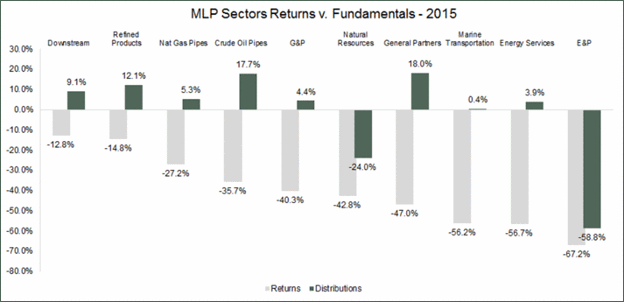CKBlog: The Market
Tuesday, January 26, 2016
MLP Analysis
by Steve Haberstroh, Managing Director
It was a rough year for Master Limited Partnership securities, commonly known as “MLPs”.
The largest MLP Index Fund, the JP Morgan Alerian MLP Index Fund, (which we have written/spoken about in the past) was down 32.96% including dividends in 2015. The price of WTI Crude was down 37.41% in 2015. Based on published research, less than 15% of the pipelines contained in this ETF have direct oil or natural gas price risk. 85% of the companies within the fund make revenues much the same way that toll roads do. The more volume that passes through their pipes, the more revenue they collect. We have found no credible evidence that the demand for oil or natural gas in this country has dropped enough to warrant such a dramatic sell off in the prices of these securities. In fact, according to Goldman Sachs, the 4th quarter 2016 demand for oil in the US was up 1.1% year-over-year. The US Energy Information Administration estimates that US oil demand will increase by 0.7% in 2016 and 1.1% in 2017. And according to Yorkville Capital Management, a respected MLP investment firm (www.yorkvillecapital.com), distributions by natural gas pipeline MLPs are expected to grow by 8% in 2016.
Over the last three to four years, and prior to the precipitous drop in MLP equity prices, there had been unprecedented investor demand for these pipeline stocks, largely due to their historically high yields. The bear case for pipelines today is that these companies in general will not be making enough revenue to continue making distributions to investors at the current pace. While it is true that several “upstream†MLPs (those which are in the business of extracting oil from the ground which carries huge price risk) have cut their distributions to investors, most major “midstream†MLPS (those which own and operate the pipelines that transport oil and gas) have not cut their distributions—in fact, some expect to increase their distributions if they have not already.
The graph on the following page (sourced: Yorkville Capital Management) depicts the disparity between different segments within the MLP universe. Notice the only two segments to reduce distributions in 2015 were in Natural Resources (minerals) and Exploration and Production companies. Also interesting is the huge disconnect between the returns of Crude Oil Pipelines and Natural Gas Pipelines compared to their distribution rates.

The three largest companies in the JP Morgan Alerian MLP Index, Enterprise Products Partners (EPD), Magellan Midstream Partners (MMP) and Energy Transfer Partners (ETP) have increased their distribution rate by 5.59%, 16.37% and 8.32% respectively in the last year. None of them have reduced their distributions in the last five years and furthermore, analysts who cover these companies expect each of them will maintain or raise their distribution rate in 2016.
One valid concern is that in order to continue to grow these companies need to keep borrowing funds (or raise capital) to continue expanding their pipelines (and therefore revenue) in order to continue increasing their distribution rates. At some point, banks may decide to lend less money to pipelines, but this has not happened yet. If banks do curtail their lending to MLPs, we believe private equity firms will step in, as evidenced by the fact that private equity firms have recently raised a record amount of capital devoted to oil and gas related companies.
There is no doubt there will be a number of companies which will be forced to cut their distributions. Some may even be forced to restructure, or worse, go bankrupt. However, given current data and expectations, it is likely to be limited to those with excessive debt or those companies which are heavily focused on extracting oil from the ground.




